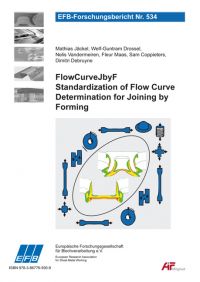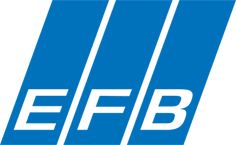Standardization of Flow Curve Determination for Joining by Forming

Verfasser:
Dr.-Ing. Mathias Jäckel, Prof. Dr.-Ing. Welf-Guntram Drossel, Fraunhofer-Institut für Werkzeugmaschinen und Umformtechnik Dresden - Ing. Nelis Vandermeiren, Ir. Fleur Maas, Belgisch Instituut voor Lastechniek vzw, Zwijnaarde - Dr.-Ing. Sam Coppieters, Dr.-Ing. Dimitri Debruyne,Mechanics of Materials, Products and Processes at Technology Campus Gent, KU Leuven
164 Seiten - 113,00 EUR (sw, 139 teils farbige Abb., 12 Tab.)
ISBN 978-3-86776-590-9
Zusammenfassung
Standardisierung der Fließkurvenermittlung für das Umformfügen
In dem beschriebenen Projekt wird die Fließkurvenbestimmung für mechanische Fügetechniken wie Clinchen und Stanznieten untersucht. Dabei wird eine prozessbasierende Methodik zur Auswahl des am besten geeigneten Fließkurvenermittlungsverfahrens für Blechen entwickelt.
Das Auswahlverfahren basiert auf einer numerischen Spannungsanalyse des jeweiligen Fertigungsverfahrens. Die Grundidee besteht darin, den dominierenden Spannungszustand im Fügeprozess zu identifizieren. Diese Information wird zusammen mit der durchschnittlichen plastischen Dehnung mit dem am besten geeigneten Materialtest zur Identifizierung der Fließkurve verknüpft. Die Methodik wird auf die Fügeverfahren Clinchen und Halbhohlstanznieten angewandt und validiert.
Bei plastisch isotropen Metallen kann die Fließkurve mit jedem Materialtest bestimmt werden, der es ermöglicht, mindestens eine echte plastische Dehnung von 0,5 zu ermitteln. In Bezug auf die maximal erreichbare wahre plastische Dehnung ist der Torsionsversuch in der Ebene allen anderen in diesem Projekt betrachteten Versuchen überlegen.
Für plastisch anisotrope Werkstoffe ist nachgewiesen, dass die vorgeschlagene Auswahlstrategie die Simulationsgenauigkeit beim Fügen durch Umformen verbessert. DC04 weist eine signifikante plastische Anisotropie auf. Beim Durchsetzfügen und Stanznieten von DC04 erweist sich durch die prozessbasierte Auswahlmethode der Stapelstauchversuch (SCT) als am besten geeignet. Es wird experimentell validiert, dass die SCT-Fließkurve tatsächlich das genaueste Simulationsergebnis liefert, wodurch die in diesem Bericht vorgeschlagene Auswahlmethode bestätigt wird.
Obwohl der SCT die genauesten Simulationsergebnisse für das in diesem Projekt betrachtete anisotrope Material liefert, muss darauf hingewiesen werden, dass diese Schlussfolgerung nur für die betrachteten Fügefälle gültig ist. Zum Beispiel ergibt die Spannungszustandsanalyse des Durchsetzens von EN AW-6082 T6 in EN AW-6082 T6 einen scherdominierten Spannungszustand.
Da EN AW-6082 T6 eine relativ schwache plastische Anisotropie aufweist, ergeben alle betrachteten Materialtests vergleichbare Fließkurven. Daher empfehlen die Autoren, vor der Auswahl des Materialtests eine Spannungszustandsanalyse durchzuführen, um die Fließkurve zu ermitteln.
Im Gegensatz zu allen betrachteten Materialtests bietet der SCT jedoch die Möglichkeit, auf einen bestimmten mechanischen Fügeprozess zugeschnitten zu werden. In der Tat wird gezeigt, dass die Stapelkonfiguration den Spannungszustand innerhalb des Stapels bestimmt. Somit kann die Konfiguration auf die Anforderungen ausgerichtet werden, die sich aus der Spannungszustandsanalyse des jeweiligen Fügeverfahrens ergeben.
Zu diesem Zweck werden die Eigenschaften des SCT im Hinblick auf eine individuelle Optimierung für das mechanische Fügen sorgfältig untersucht. Es zeigt sich, dass ein größerer Rondendurchmesser die Druckspannungskomponente erhöht und damit eine bessere Vergleichbarkeit zum Clinchen und Stanznieten gegeben ist. Darüber hinaus wirken sich größere Rondendurchmesser positiv auf die Robustheit der Versuche aus. Um dennoch hohe Verformungsgrade zu erreichen, sind je nach Werkstoff zum Teil sehr hohe Presskräfte erforderlich.
Aus wissenschaftlicher Sicht wird bei der Optimierung des SCT für das mechanische Fügen eine interessante Beobachtung gemacht: Der Einfluss der Stapelkonfiguration auf die Fließkurve stellt sich als werkstoffabhängig heraus. Es wird die Hypothese aufgestellt, dass der hydrostatische Druck einen Einfluss auf die Fließkurve hat. Dieser Effekt ist bei dem in diesem Projekt betrachteten hochfesten Stahl (CR330590-DP) am stärksten ausgeprägt. Der Unterschied im Fließverhalten könnte auf eine hydrostatische Druckverschiebung zwischen den Spannungszuständen zurückzuführen sein.
Förderhinweis
The publication "FlowCurveJbyF - Standardization of Flow Curve Determination for Joining by Forming" (Standardisierung der Fließkurvenermittlung für das Umformfügen) shows the results of the industrial research project EFB/AiF-Nr: 215EBR, that was supervised by the EFB European Research Association for Sheet Metal Working (Europäische Forschungsgesellschaft für Blechverarbeitung e.V.) Hannover.
The project was supervised by the EFB. In the scope of the CORNET - European Research Programme it was funded by the German Federal Ministry for Economic Affairs and Energy via the Federation of Industrial Research Associations (AiF - Arbeitsgemeinschaft industrieller Forschungsvereinigungen e.V.) on the basis of a decision by the German Bundestag. The results are edited by EFB-Verlag as EFB-Research Report No. 534.
Summary
The demands for joining techniques increased significantly in the last decade. Today, structures are highly optimized to meet stringent requirements with respect to a variety of performance metrics such as weight, safety and environmental impact. Given that FE modules dedicated to simulating joining by forming process reached a sufficiently high level of maturity, simulation is increasingly used by SMEs for numerical process development, and, through the increasing digitization, also for datamining.
In important caveat, however, is that the predictive accuracy of these FE simulations strongly depends on, amongst others, the adopted material model. For an accurate calculation of the joint geometry and its mechanical strength, accurate large strain flow curves are required. A myriad of experimental techniques have been developed to determine the large strain flow curve of sheet metal. In this regard, there are two issues.
Firstly, these material tests are typically dominated by a certain stress state and yield different results depending on the degree of plastic anisotropy exhibited by the sheet metal. Secondly, due to the small dimensions of the forming tools (e.g. punch or rivet) compared to the nominal sheet thickness, joining by forming processes of sheet metal must be regarded as a bulk forming problem in which the through-thickness stress cannot be ignored. The crux of the problem here is that the plastic material behaviour of sheet metal is conventionally determined using material tests, which are confined to homogeneous plane stress conditions in the plane of the sheet.
Due to a multitude of methods for determining flow curves and the variety of phenomenological hardenings laws models to describe them, problems arise with respect to reproducibility and accuracy in joining by forming simulations. The latter threatens the advantages of numerical process development.
The aim of this research project is to devise a process-informed selection strategy for the selection of flow curves determination methods tailored for FE simulations in mechanical joining. The key point of the method is the identification of the dominating stress state in the joining by forming process at hand, which is then used to select the most appropriate material test to identify the large strain flow curve.
Several material tests are conducted in collaboration with research labs and institutes across the globe. The developed selection strategy is applied to two representative joining by forming techniques, namely clinching and self-pierce riveting. The experimental validation enabled to derive guidelines to identify accurate flow curves for simulating joining by forming processes.
The framework presented in this report enables to arrive at industrial relevant guidelines for the selecting the most appropriate method to identify the large strain flow curve, and, consequently, increase the accuracy of numerical process development in joining by forming.
Table of contents
Zusammenfassung
List of figures
List of tables
1 Introduction
2 State of the art
2.1 Self-pierce riveting
2.2 Clinching
2.3 Flow curve determination for mechanical joining
2.4 Large strain flow curve of sheet metal
2.4.1 Large strain flow curve
2.4.2 Identification Methods for acquiring large strain flow curves
3 Problem and research objective
4 Materials, equipment and tools
4.1 Investigated materials
4.2 Joining setup
4.3 Joining elements and tools
4.3.1 Self-pierce riveting
4.3.2 Clinch forming
5 Experimental joint analysis
5.1 Procedure
5.2 Self-pierce riveting
5.3 Clinching
6 Simulation models of the joining processes
7 Material testing requirements for joining by forming
7.1 Plastic anisotropy
7.2 Large strain flow curve
7.3 Strain rate effect
7.3.1 Numerical
7.3.2 Experimental
7.4 Conclusions
7.4.1 Plastic Anisotropy
7.4.2 Flow curve data
8 Material characterization methods
8.1 Tensile test
8.2 Extended tensile test
8.3 Stack compression test (SCT)
8.4 Plane strain compression test (PSCT)
8.5 In-plane torsion test (IPPT)
8.6 Hydraulic bulge test (HBT)
9 Numerical stress analysis
9.1 Stress-state metric
9.2 Process-informed method selection
9.3 Clinching
9.4 Self-pierce riveting
9.5 Material characterization tests
9.5.1 Extended Tensile Test
9.5.2 Stack compression test
9.5.3 Plane strain compression test
9.5.4 In-plane torsion test
9.5.5 Hydraulic bulge test
9.5.6 Summary
9.6 Comparison of joining processes and material tests
10 Experimental and numerical study of the stack compression test
10.1 Initial state and parameters of the stack compression test
10.2 Manufacturing process of the discs
10.3 Influence and correction of friction
10.4 Influence of diameter and number of discs
10.5 Influence of a shift in hydrostatic pressure
10.5.1 Experimental
10.6 Round Robin test
10.6.1 KUL experiments
10.6.2 Comparison of IWU and KUL experiments
11 Evaluation of flow curves from considered material tests
11.1 Flow curve extrapolation
11.2 Flow curve comparison
12 Determination of flow curves for SPR-ST rivets
13 Numerical assessment of flow curves
13.1 Flow curve comparison for self-pierce riveting
13.2 Flow curve comparison for clinching
14 Recommendations for flow curve determination for mechanical joining
15 Project Results
16 List of Literature
17 Attachments

